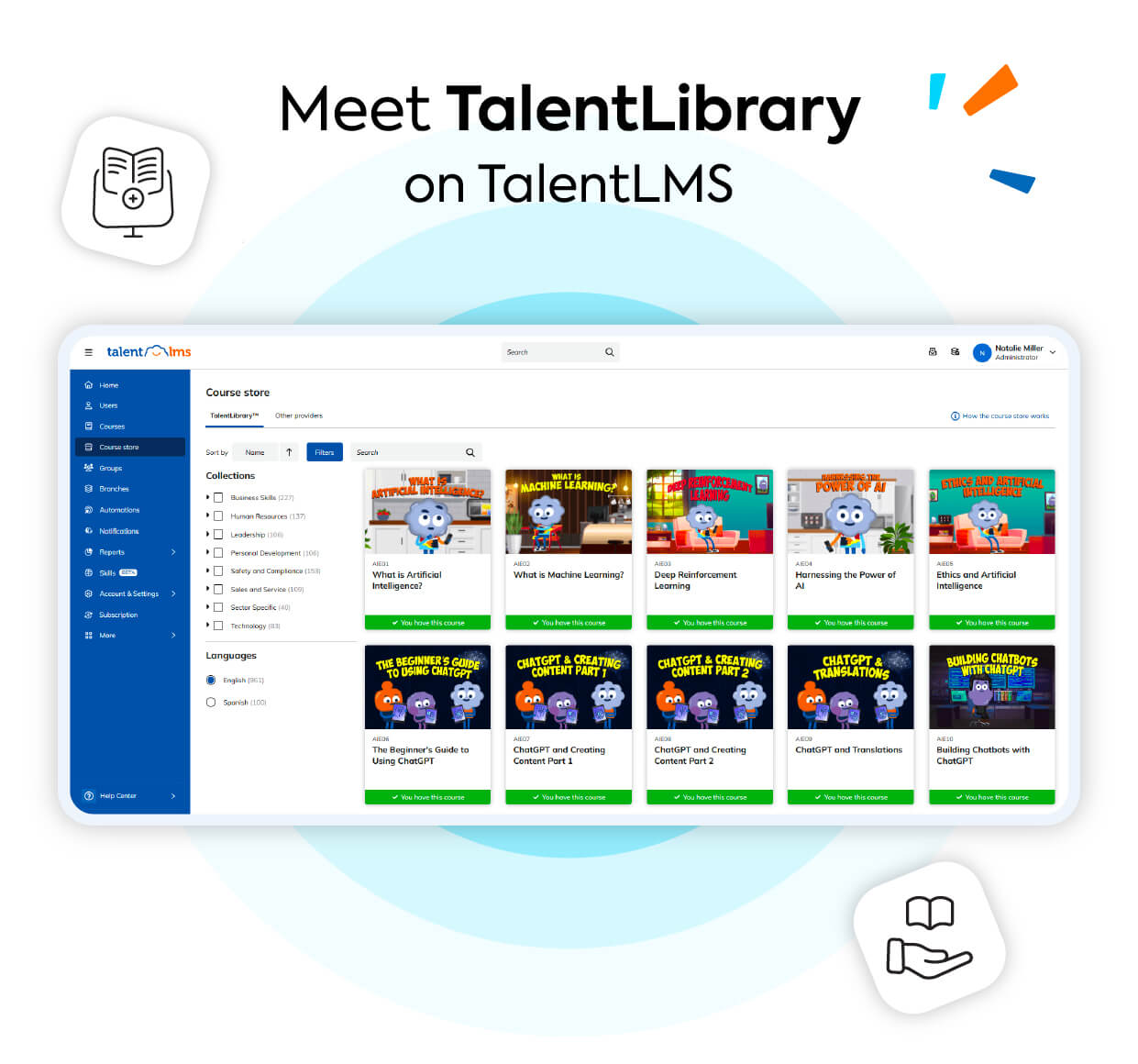- What is knowledge sharing in the workplace?
- The impact of silos on knowledge sharing
- Benefits of encouraging a knowledge-sharing culture
- Challenges of knowledge sharing in the workplace
- Types of knowledge sharing
- Best practices for building a knowledge-sharing culture that eliminates silos
- Knowledge sharing is caring
Have you ever found yourself thinking, “If only I had known this sooner, I could’ve saved so much time!” Or maybe your colleagues have shared, “I didn’t know we had a tool for that,” or “How was this problem solved before?”
Such situations are all too common. And they point to a bigger issue in many organizations.
Knowledge isn’t being shared effectively.
Effective knowledge sharing in the workplace doesn’t mean making sure people know where to find files. It’s about fostering a culture where people naturally exchange collective knowledge. For instance, ideas, learnings, and solutions to help the entire company succeed. Without it, team members can feel disconnected, work gets arduous, and opportunities for innovation slip through the cracks.
Let’s walk through what knowledge sharing looks like in a modern workplace, why it’s important, and how you can weave it into a thriving company culture.
What is knowledge sharing in the workplace?
Knowledge sharing means making information, insights, and expertise accessible to everyone who needs it. It means ensuring that valuable knowledge (documented or undocumented) flows freely across departments, team members, and individuals.
It might sound simple. But knowledge sharing involves a lot more than simply passing along info. It’s about creating a whole system where knowledge is consistently shared. Whether this is in a formal presentation, an informal chat, or through digital tools that everyone has access to.
So, why does knowledge sharing matter?
When knowledge is shared, companies don’t just operate more efficiently. They thrive.
Think about this. When employees have quick access to the information they need, they can make faster decisions, solve problems more easily, and learn from each other’s successes (and mistakes). When employees and team members stop sharing knowledge and start working in isolation, you miss out on those benefits.
For instance, studies show that teams with strong collaboration and knowledge sharing are more productive and innovative.
Here’s why it’s crucial:
- It prevents bottlenecks. When one person or team is the only source of key information, things can grind to a halt if they’re unavailable. Shared knowledge ensures continuity.
- It improves decision-making. When people have the right information at the right time, they’re more equipped to make smart, informed decisions.
- It fosters innovation. The more ideas and information are shared, the more opportunities there are for innovation. Different perspectives coming together spark new ideas.
- It helps new hires and younger workers learn the ropes faster. A culture where employees share knowledge makes onboarding smoother and quicker for new hires, allowing them to hit the ground running.

The impact of silos on knowledge sharing
Silos are the kryptonite of your knowledge-sharing system. This happens when team members hold on to information instead of sharing it with others.
Such communication barriers that disrupt knowledge sharing happen for many reasons, including geographic separation, different time zones, or simply not having the right tools for communication.
Regardless or the reason, the impact of silos is always the same. For example, when one team doesn’t know where another is in a production cycle, it’s hard to plan for or hit important deadlines. Critical problems that come up don’t get communicated until one team or worker hands off the project to the next. This causes potential rework as they scramble to address an unanticipated issue.
Silos harm good communication and effective knowledge sharing. If you want the advantages of a knowledge-sharing culture, you need to remove these barriers.
But why do silos form in the first place?
Silos don’t always form because people keep information to themselves on purpose. People often end up working independently within a company not because of toxic work culture but because of circumstances outside of their control.
For instance, even the most well-meaning team member stops sharing information when they’re under tight deadlines. They have to focus all their time and energy on urgent tasks and outcomes to meet expectations.
It’s also easy for people to start working in a bubble when a team is distributed across locations. Differences in time zones and working hours can make it difficult to keep up with information and engage in knowledge sharing in real-time. And a lack of opportunities to casually bump into each other in the break room eliminates informal communication.
Working from home can also leave employees feeling isolated and to miss out on knowledge sharing. When companies don’t have plans in place to keep everyone in sync, it’s easy for people to get used to just doing their job and not reaching out to connect their work with the bigger picture.
Benefits of encouraging a knowledge-sharing culture
By breaking down silos and promoting a culture of knowledge sharing, you are set to reap a lot of benefits for the entire organization. Let’s see how a knowledge-sharing culture impacts your business:
1. Boosts productivity
When people can access the information they need without jumping through hoops, they get more done. Instead of spending hours searching for answers or recreating the wheel, they can tap into existing knowledge and apply it right away with the help of knowledge sharing.
2. Improves team collaboration
Any culture that encourages knowledge sharing helps break down barriers between departments. When people regularly share insights, everyone works together more effectively, bringing diverse ideas to the table. This level of collaboration usually leads to better outcomes than what any person could achieve alone.
3. Accelerates employee L&D
Learning doesn’t always have to be formal training sessions. When everyone is willing to share their expertise, people benefit from hands-on knowledge that’s relevant to the task at hand. This peer-to-peer learning helps everyone continuously develop new skills and grow professionally.
4. Boosts employee morale
When people feel they’re contributing to the greater good by sharing what they know, it creates a sense of purpose and community. Also, when information flows freely, individuals are more likely to feel supported in their roles. Which, in turn, increases job satisfaction and retention.
Challenges of knowledge sharing in the workplace
Building and maintaining a company culture that promotes knowledge sharing can be easier said than done. Here are some of the common challenges organizations face.
Time pressure. One of the most common challenges to sharing knowledge is a lack of time. Employees juggle multiple projects, so they may not prioritize sharing what they’ve learned. Especially if they don’t see immediate benefits from doing so.
Fear of losing job security. It’s possible that some employees feel that if they share their unique, explicit knowledge, they’ll lose their competitive edge or job security.
Lack of the right tools. Maybe your company doesn’t have the right tools for sharing knowledge. Then, information can easily get lost along the way.
Types of knowledge sharing
There are several types of knowledge sharing at work. Each fosters communication, collaboration, and learning within an organization.
They vary based on the nature of the knowledge, the tools used, and the people involved. Here are some common knowledge-sharing types:
Formal
Formal knowledge sharing can include:
- Training and workshops: Structured learning environments where people get instruction on specific skills, processes, and topics.
- Mentorship, coaching, and job shadowing: More seasoned employees guide less experienced colleagues through 1:1, small group interactions, or on-the-job.
- Standard operating procedures (SOPs): Documents outlining step-by-step processes important for consistency and knowledge transfer.
Informal
It can take place in the form of:
- Peer-to-peer conversations: Casual discussions in person or through communication tools like Slack and email. These spread knowledge organically.
- Watercooler chats: Informal conversations that take place naturally in shared spaces, often leading to unplanned sharing of insights.
- Ad-hoc problem solving: Spontaneous collaboration where individuals help each other solve work-related issues when they arise.
Team-based
Let’s see what team-based knowledge sharing looks like:
- Team meetings: Regular discussions where updates, new ideas, and solutions to projects are shared in a team.
- Project collaboration: When working together on shared goals and projects, people exchange knowledge and expertise.
- Retrospectives/Post-mortems: Teams have the chance to reflect on a project or initiative’s successes and challenges to discover insights for future work.
Digital
Digital knowledge sharing can take place through:
- Knowledge management systems (KMS): Centralized platforms where employees can document and share company knowledge.
- Internal wikis: Collaborative, editable platforms that allow users to create and modify content related to the company’s processes, tools, and best practices.
- Discussion boards and Q&A platforms: Digital spaces where employees can ask questions and share knowledge asynchronously.
Best practices for building a knowledge-sharing culture that eliminates silos
To break down silos, you must establish formal and intentional knowledge management and knowledge-sharing strategies. And that requires ongoing effort.
A one-time presentation on the importance of knowledge transfer and collaboration might make people aware of the problem, but it won’t be enough to create and sustain organization-wide change. Here are five ways you can help your teams work together and communicate effectively over the long term.
1. Create a culture of lifelong learning through collaboration
Build an environment that makes it easy to communicate openly by helping current and future employees get to know one another and build relationships of trust.
You can do this with casual interactions or formal meetings. For instance:
- Schedule informal team lunches or social activities to create bonding
- Hold an all-hands meeting once a month to discuss wins and make big announcements
- Hold regular breakout sessions for teams to discuss issues with their managers or brainstorm new ideas
- Invite subject-matter experts to share their knowledge in informal lunch meetings
Whatever approach you take, ensure you’re giving current and future employees frequent opportunities to get to know their coworkers and exchange information.
2. Invest in employee development
Give people the tools and knowledge they need to do their jobs. Training is perhaps one of the most basic forms of knowledge-sharing strategies, but it can have a big impact on your company’s success.
Beyond giving people the information to succeed, employee training also helps you create a culture of learning that will keep employees engaged. You’re showing employees you’re invested in them, communicating not only necessary skills and tools but also a sense of your values and priorities.
Make sure you have a plan in place for remote and hybrid training so you include all employees equally.
3. Coach employees in soft skills
Even when people have opportunities to share information, they may not always know how to do so effectively. Soft skills training gets people up to speed on the best ways to work with others by teaching things like communication, adaptability, and creativity.
An ongoing program of coaching in these areas can help people understand how to communicate vital information in a way that’s clear and that helps others take action. It can also show them how to adapt to new knowledge that affects their work.
4. Provide mentorship opportunities
Many job skills can be covered in formal training, but there’s a lot to be gained from on-the-job learning, even in remote or hybrid settings. Mentorship is a way of sharing knowledge between newer workers and their more experienced counterparts.
Consider ways to involve members of a distributed team as well. Developing a mentorship program for remote workers will benefit your employees in two ways: you’ll ensure job knowledge is passed on, and you’ll help remote employees feel more connected to the company.
5. Encourage employees to use knowledge-sharing tools
Communication tools are critical to keeping people in the loop–especially in remote or hybrid workplaces. When different teams are using different tools, information can sometimes fall through the cracks.
Establish standards for communication within your organization to make regular communication easier and more likely. Chat tools like Slack or MS Teams support informal communication where employees can share thoughts, interesting articles, opinions, or concerns.
More formal project or task management tools like Trello or Asana ensure critical changes in project status are communicated immediately. When it comes to the tools you use, establish standards so everyone’s on the same page and getting crucial knowledge in real time.
6. Lead by example
Do you want employees to share knowledge? Then, leadership has to do it first to show the way. When leaders openly share information, it sets the tone for the rest of the company.
Employees are more likely to follow suit when they see this behavior modeled at the top.
7. Recognize and reward sharing
To further encourage a knowledge-sharing culture, it’s necessary to recognize and reward employees who do it well.
To recognize and reward employees who actively share their knowledge means encouraging knowledge-sharing behaviors. Recognition and rewards may occur through formal recognition programs, bonuses, or even a shout-out in a team meeting.
Knowledge sharing is caring
Effective knowledge sharing isn’t just about speeding up tasks. It’s about establishing a vibrant, resilient organization where everyone’s contributions matter.
When people feel confident to share their expertise, they foster a culture of teamwork, innovation, and continuous growth. The ripple effect? Higher engagement, breakthroughs, and a company that thrives.
Break down silos and encourage open communication and knowledge transfer to unleash your team’s full potential and set the stage for long-term success. Why wait for those “aha” moments to happen by chance? Create a culture where they happen daily, and watch your business soar.
Let’s get knowledge transfer moving!
Originally published on: 02 Mar 2023 | Tags: Employee development,learning and development





